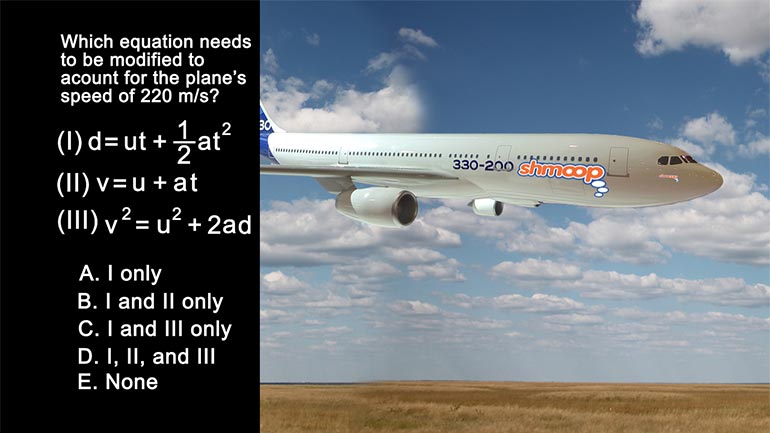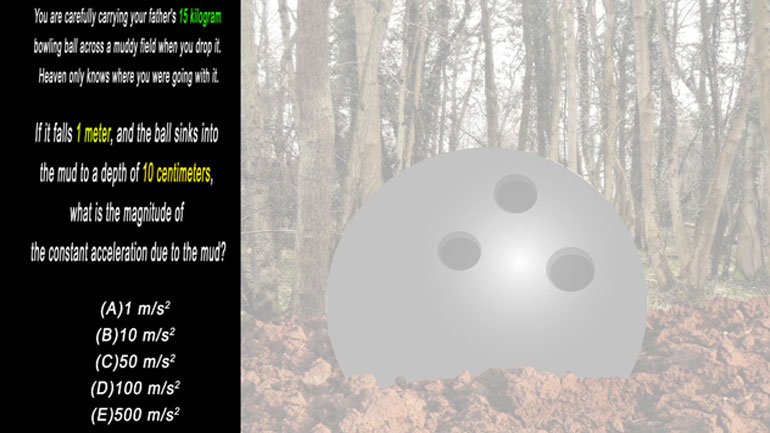ShmoopTube
Where Monty Python meets your 10th grade teacher.
Search Thousands of Shmoop Videos
AP Physics B/C Videos 8 videos
AP® Physics B: Newtonian Mechanics Drill 1, Problem 3. With what acceleration does lunch arrive?
AP Physics C: Newtonian Mechanics Drill 1, Problem 1. Which of Newton's equations of motion would have to be modified to account for the airplane's...
Newtonian Mechanics Drill 1, Question 1. What is the magnitude of the constant acceleration due to the mud?
AP Physics B 1.3 Newtonian Mechanics 192 Views
Share It!
Description:
AP® Physics B: Newtonian Mechanics Drill 1, Problem 3. With what acceleration does lunch arrive?
Transcript
- 00:03
Here's your shmoop du jour, brought to you by the falling apple, sponsored by gravity.
- 00:09
Your tree house has a sweet system for bringing food up to you without making you go down the rope ladder.
- 00:16
Two baskets are connected by a light string over a massless pulley.
- 00:24
One rests at the bottom of the tree, and the other is at the level of the tree house.
- 00:28
When your mom comes by and puts your box of Lunchables in the lower basket, you add rocks
Full Transcript
- 00:33
to the upper basket. The heavier basket falls, and the lighter basket rises.
- 00:37
Lunchables are served! If we assume that the pulley is frictionless,
- 00:42
the basket of highly processed snack food has a mass of 2 kilograms, and the baskets
- 00:48
of rocks has a mass of 6 kilograms... ...with what acceleration does your lunch arrive?
- 00:55
And here are the possible answers...
- 01:00
Before we even do any calculations, we can eliminate every choice except for A or B.
- 01:06
Objects near the surface of the earth accelerate at 9.8 meters per second squared, which
- 01:12
can round to about 10.
- 01:15
However, since we have two baskets, accelerated
- 01:18
by gravity working against each other,
- 01:20
we know that the net acceleration MUST be less than 10.
- 01:31
We don't know exactly how much less, but we're left with A and B.
- 01:36
This is a pretty complex system, and finding
- 01:37
acceleration won't be as simple as eating that delicious lunch dear old Mom sent you.
- 01:42
But a little complexity never stopped us... To find acceleration, we need to look at each
- 01:47
basket and the forces acting on that basket.
- 01:51
To start, we'll look at the one with the food in it.
- 01:54
The basket has two forces on it: Gravity and tension.
- 01:59
Gravity points down, as always, and tension points up.
- 02:04
Now, when we're solving a physics problem, we can't go wrong with F = m times a.
- 02:09
We know that the net force on this object is equal to its mass times its acceleration,
- 02:14
which we're trying to find. The net force is also equal to the sum of
- 02:18
the forces acting on the basket.
- 02:25
Tension and gravity are working in opposite directions,
- 02:28
so one must be negative.
- 02:30
Since our lunch is accelerating up... which hopefully won't happen after we eat it...
- 02:35
...we will call that one positive, and down will be negative.
- 02:40
Our net force is then also equal to T minus m times g.
- 02:48
The second basket, the one with the rocks,
- 02:50
is in a similar situation. We use F = m times a to find that the net
- 02:55
force on the basket with the rocks is also equal to its mass times acceleration, and
- 03:00
the sum of the forces acting on it. But wait! We almost made a terrible mistake.
- 03:06
For the basket with the lunch, we made acceleration upwards positive, so we have to keep it consistent...
- 03:12
The basket with the rocks is accelerating downwards, so we have to make acceleration
- 03:17
negative. Our equation then looks like this: We now have two equations that we know to
- 03:23
be true about this system: We know the mass of the two baskets, and the
- 03:27
force of gravity... which leaves only acceleration, which we're trying to find... and tension.
- 03:33
We know that acceleration and tension must be the same for the two baskets because they're
- 03:37
part of the same system.
- 03:39
This leaves us with a system of two equations for us to solve.
- 03:43
To begin, we isolate T for both equations.
- 03:46
We add m times g to both sides of both equations, and we get the following:
- 03:57
Then, we set the two equations equal to each other, so we get that the mass of lunch times
- 04:01
acceleration... plus the mass of lunch times the acceleration due to gravity... is equal
- 04:06
to the negative mass of the rocks times acceleration... plus the mass of the rocks times gravity.
- 04:12
Plugging in values, we get 2a plus 2 times 10 is equal to negative 6 times a plus 6 times 10.
- 04:23
We add 6a to both sides and subtract 20 from both sides to get 8a is equal to 40.
- 04:29
Finally, we divide both sides by 8 to get
- 04:31
the acceleration is equal to 5 meters per second squared.
- 04:35
So the basket accelerates at 5 meters per second squared...
- 04:38
...which is answer B. As in, "Barely edible."
Related Videos
AP Physics B: Newtonian Mechanics Section Drill 2, problem 1. What is the acceleration due to gravity for objects dropped near the surface of Europa?
AP Physics C: Newtonian Mechanics Drill 1, Problem 1. Which of Newton's equations of motion would have to be modified to account for the airplane's...
Newtonian Mechanics Drill 1, Question 1. What is the magnitude of the constant acceleration due to the mud?
AP® Physics B: Newtonian Mechanics Drill 2, Problem 2. If she is to stay on a course due north, at what angle must she point her plane?
AP® Physics B: Newtonian Mechanics Drill 2, Problem 3. What is the coefficient of friction between the biscuit and the court?







